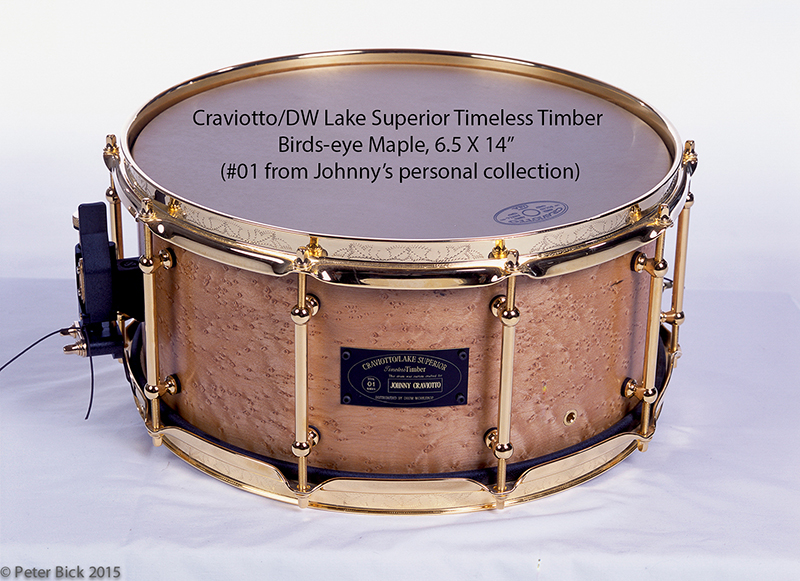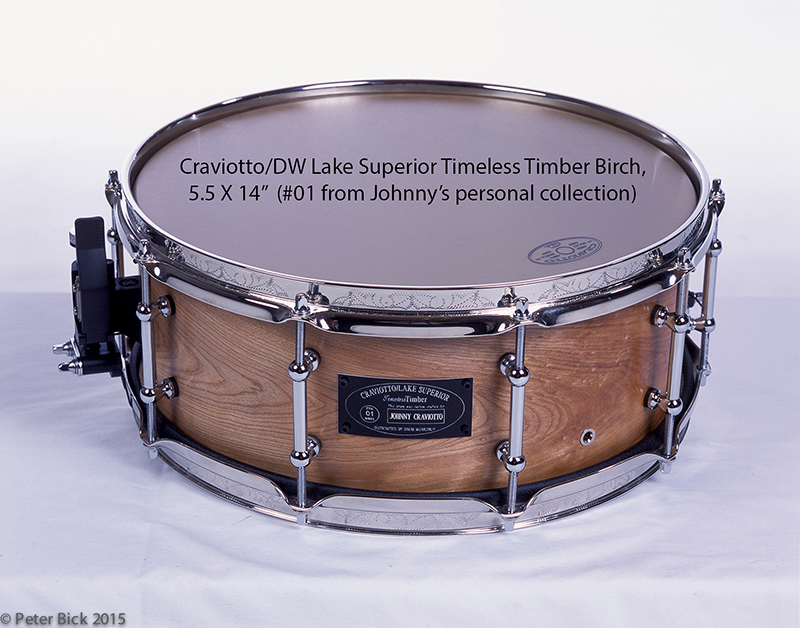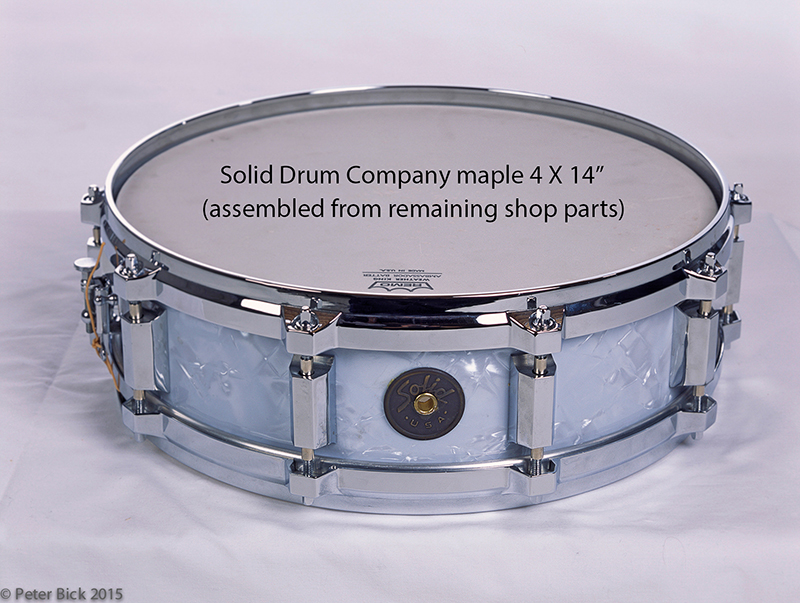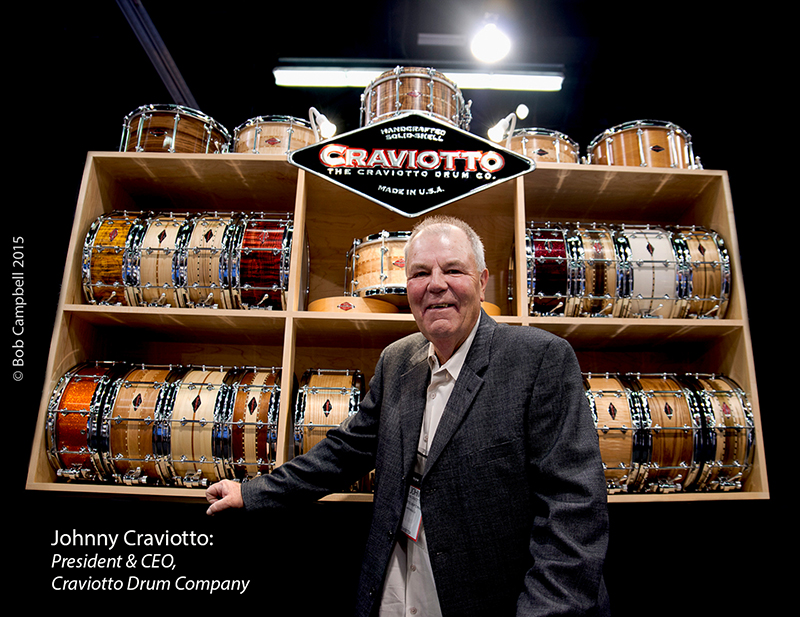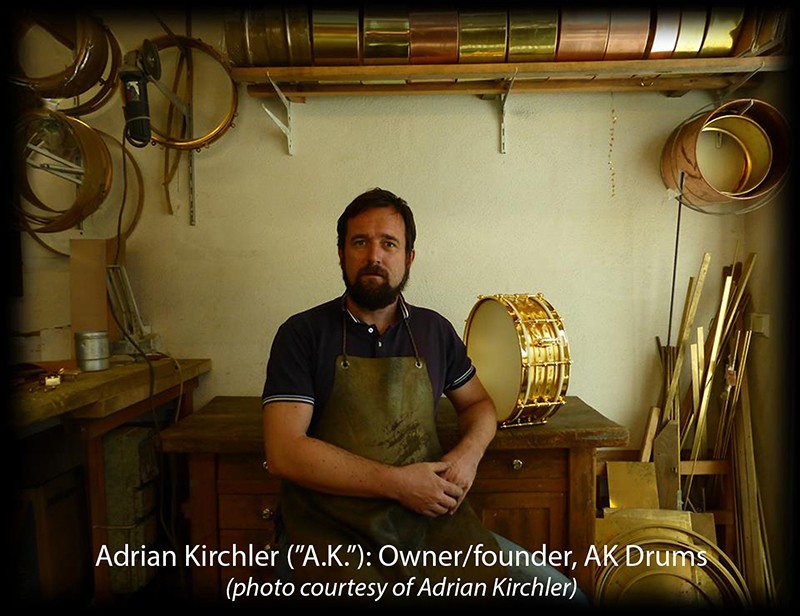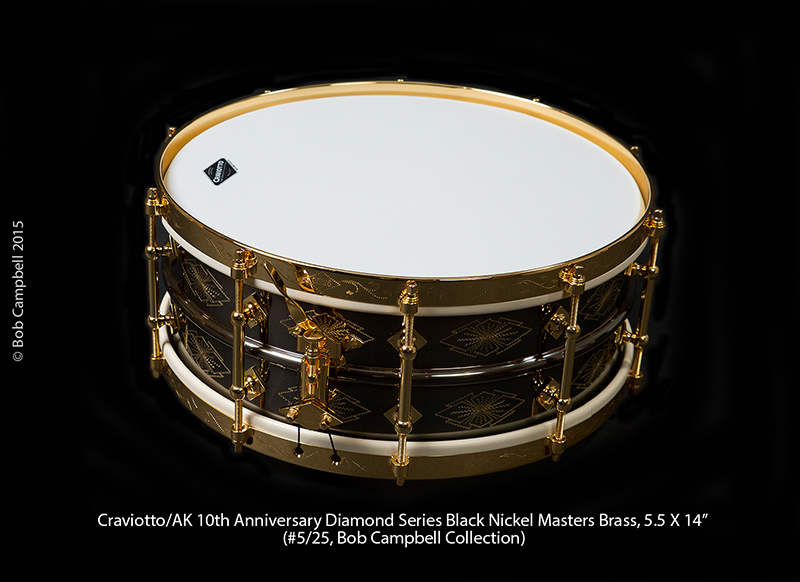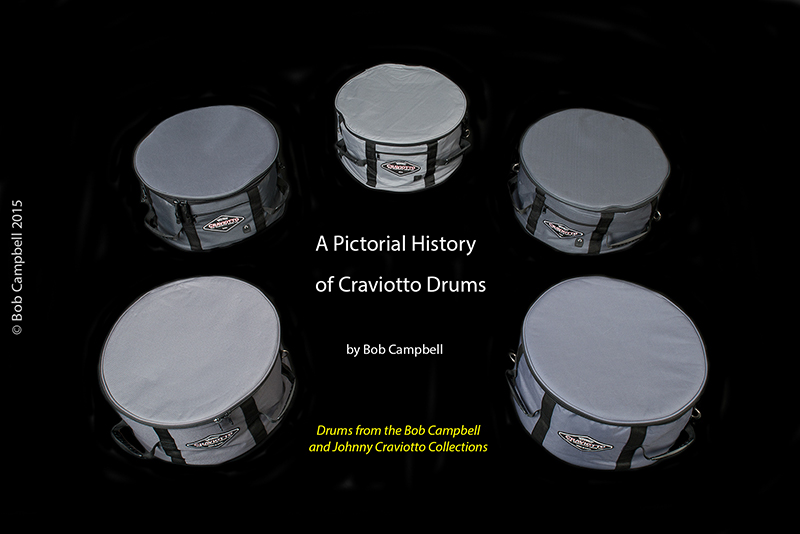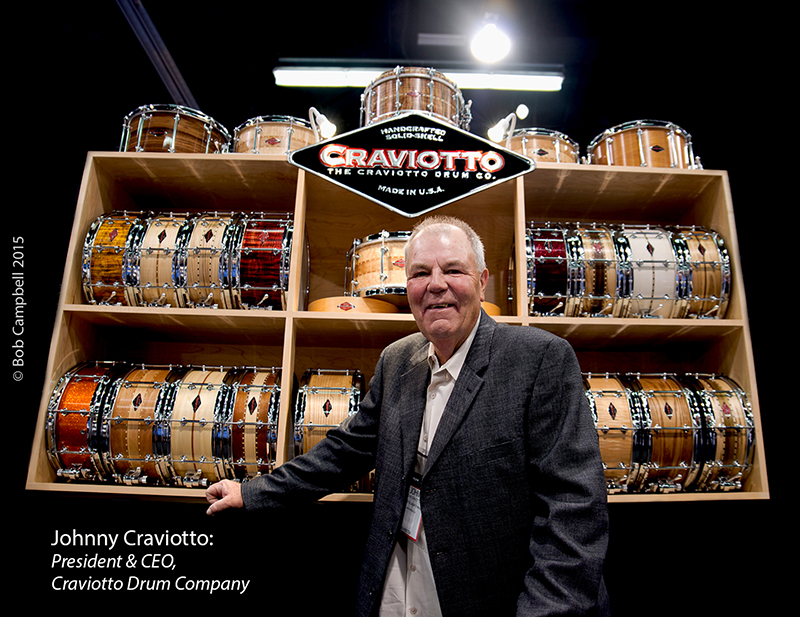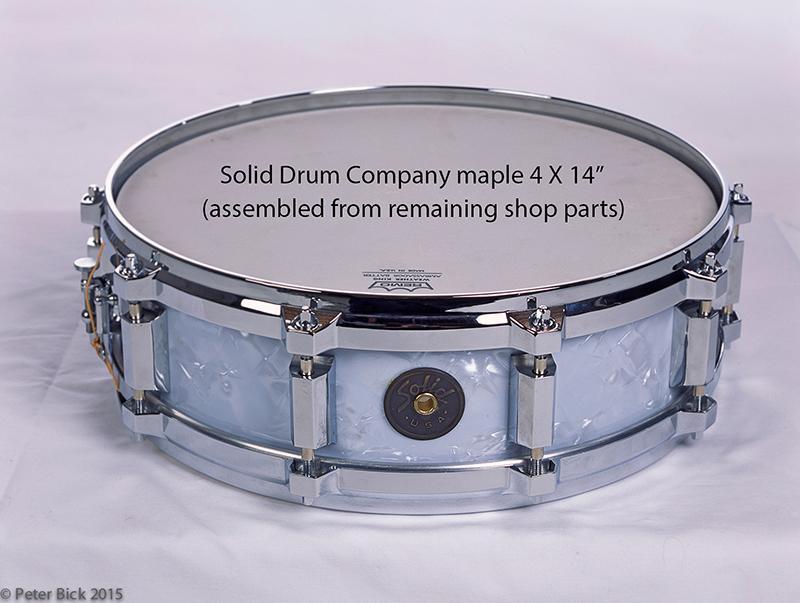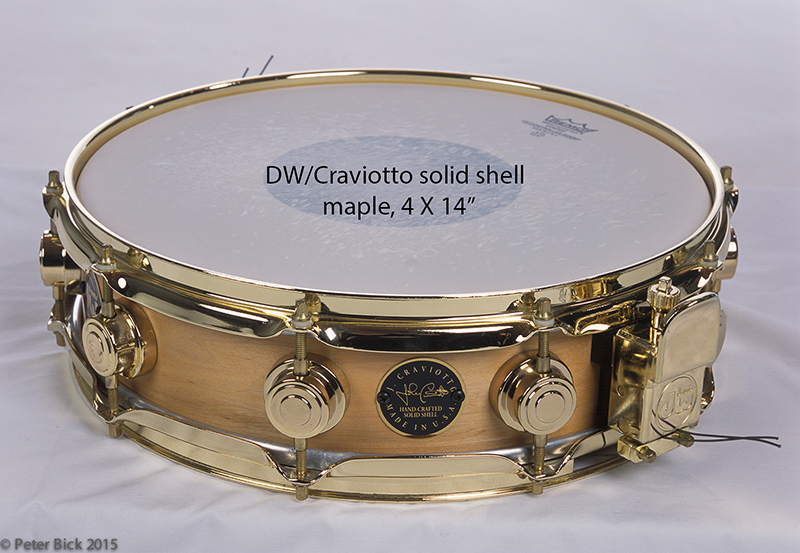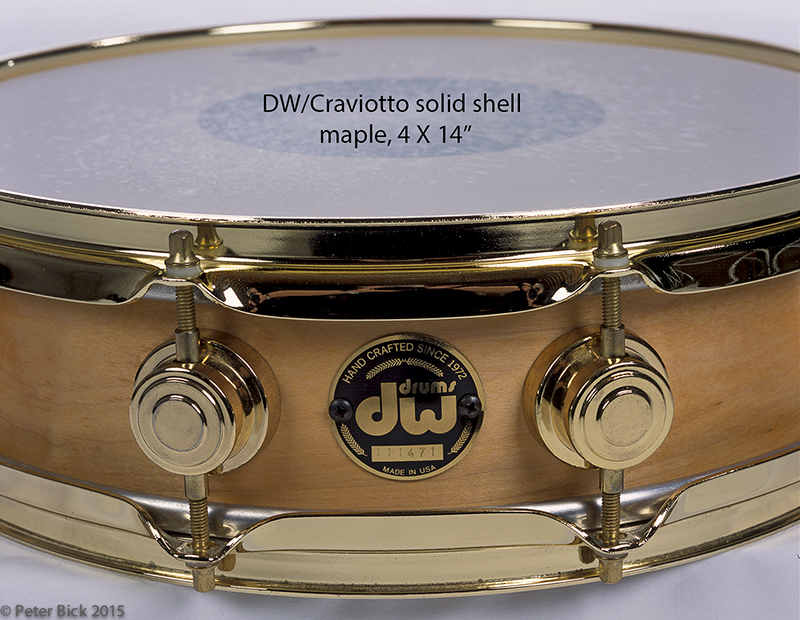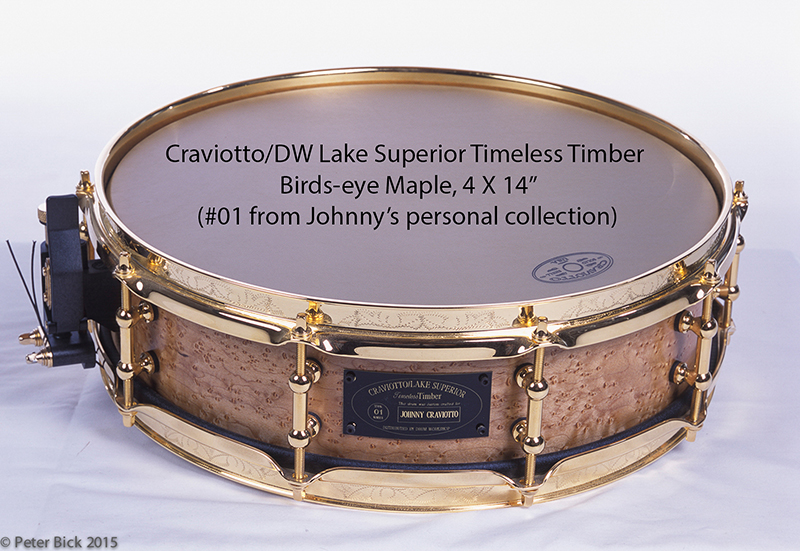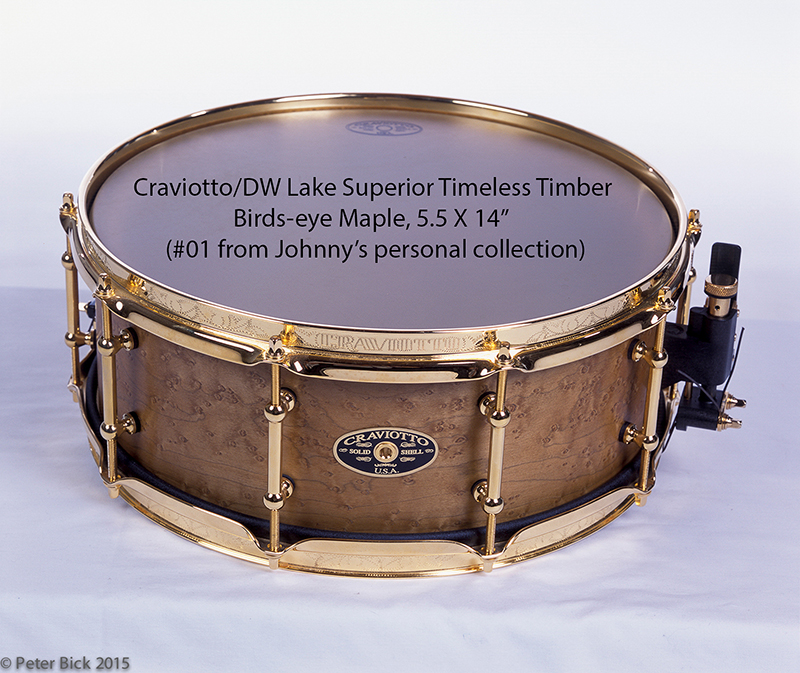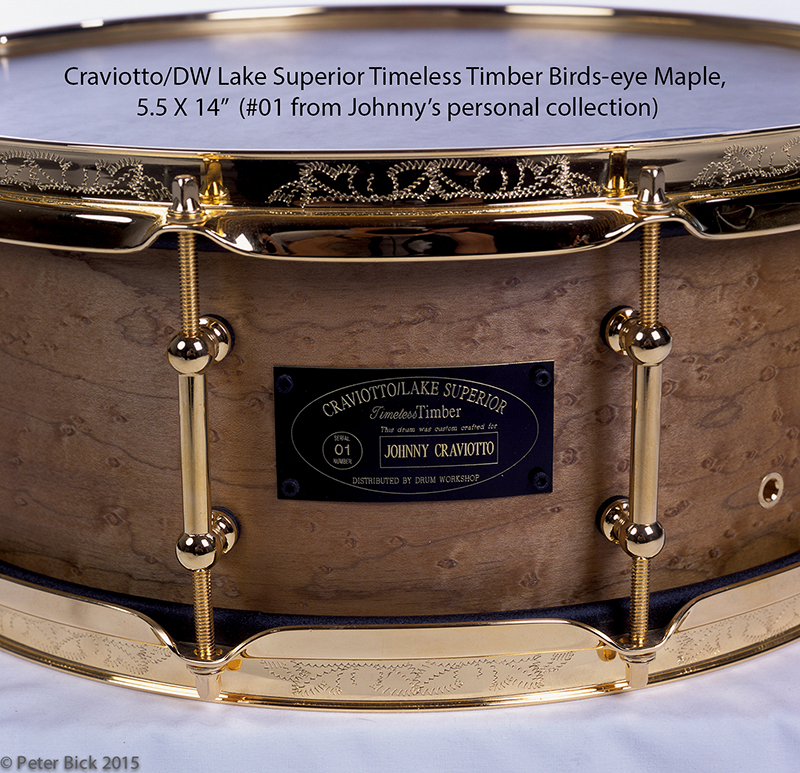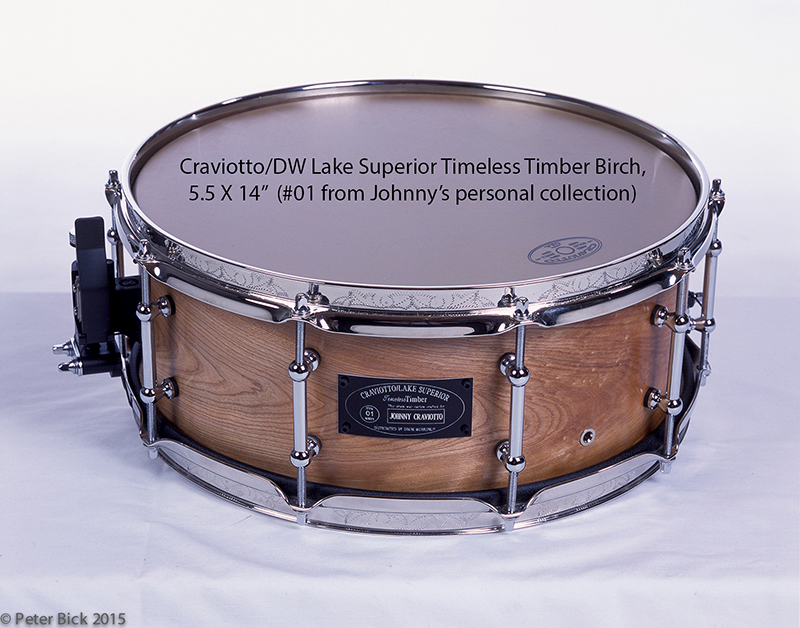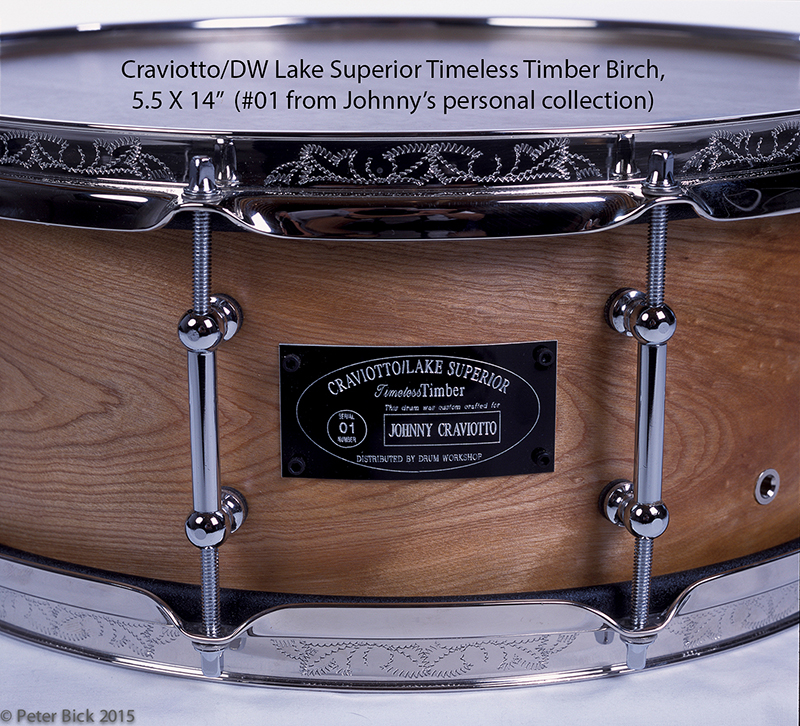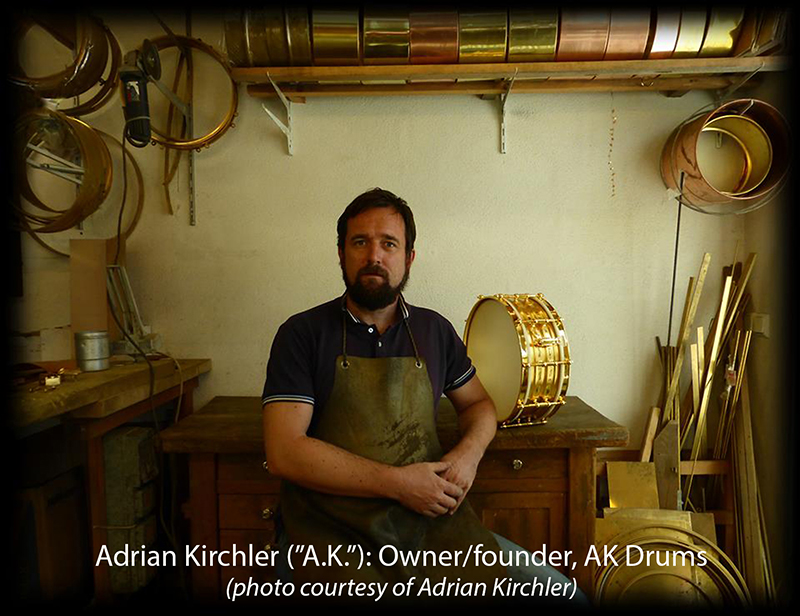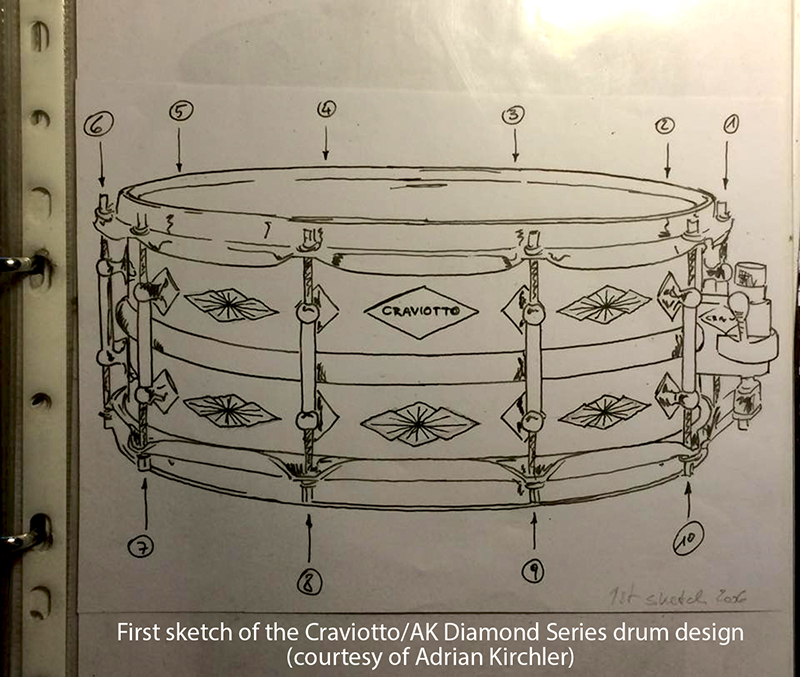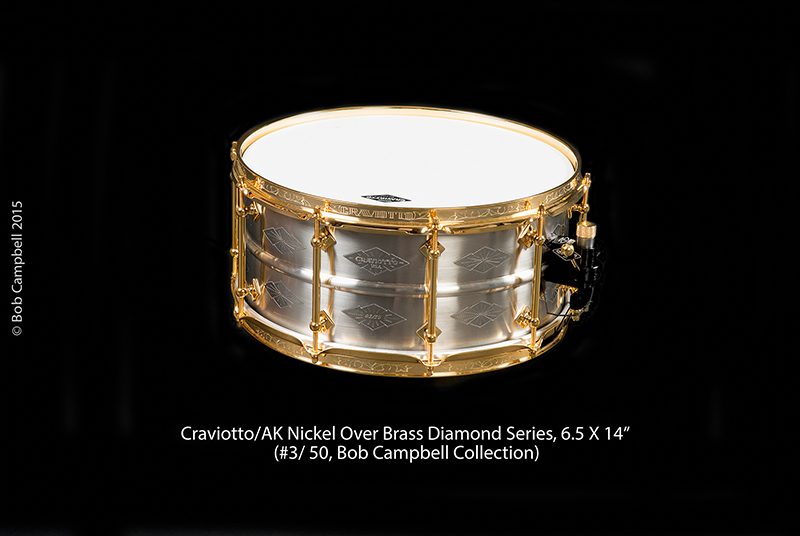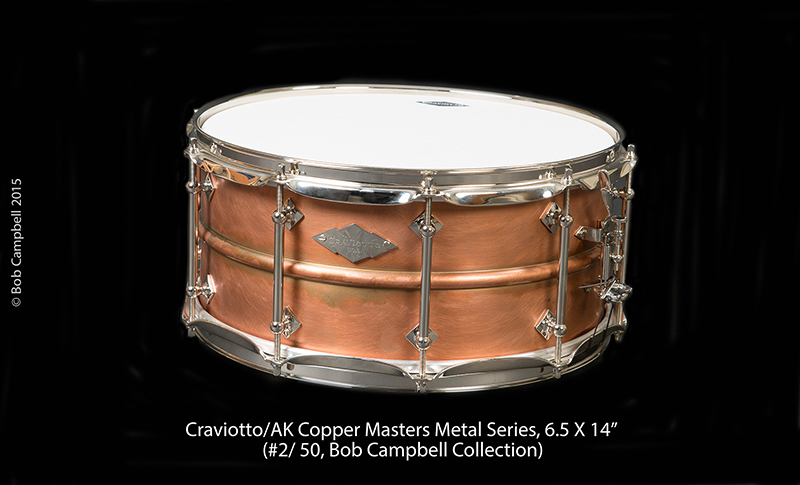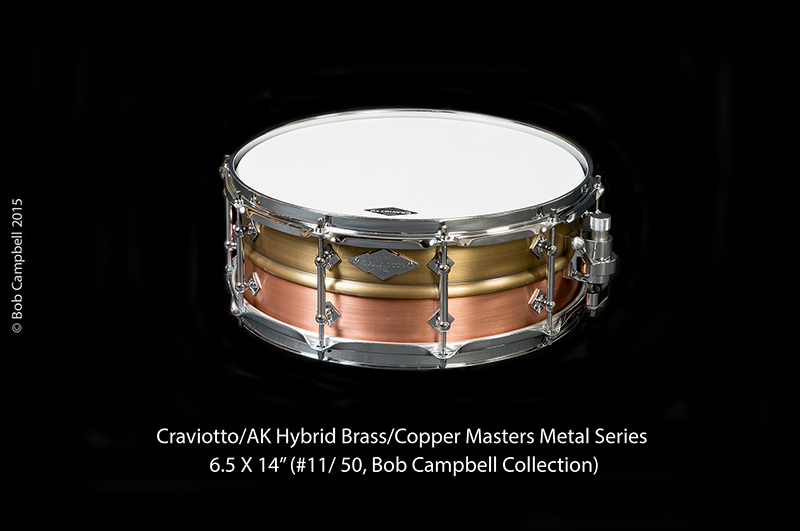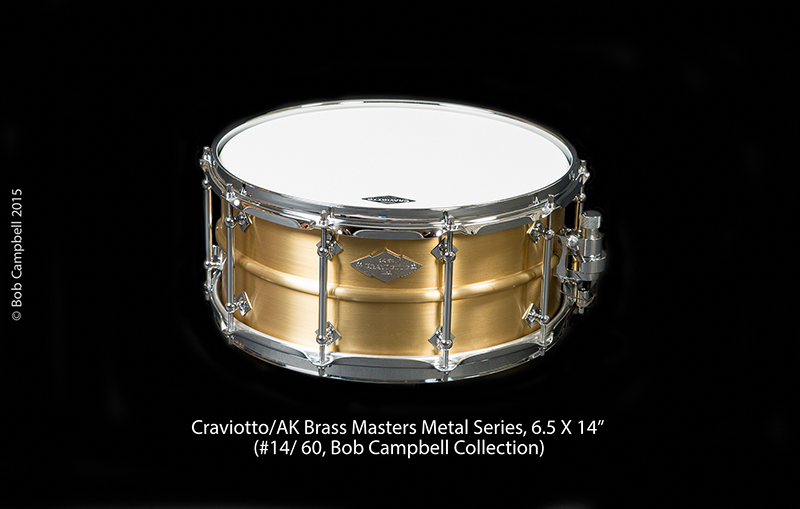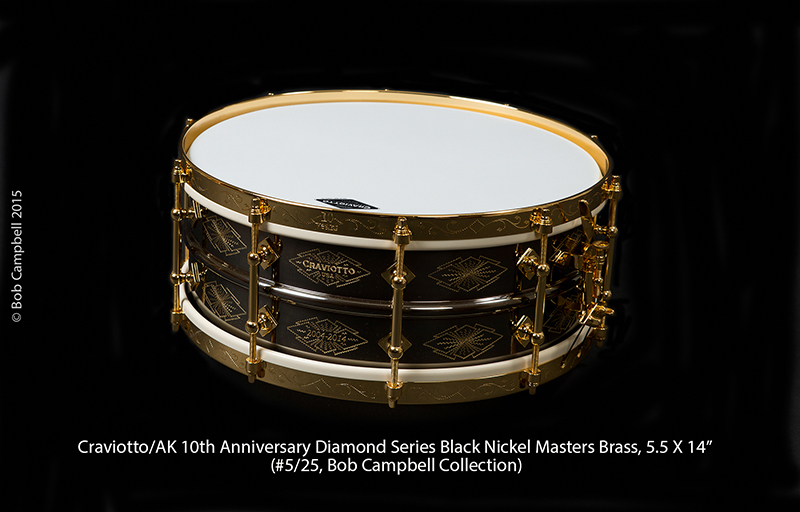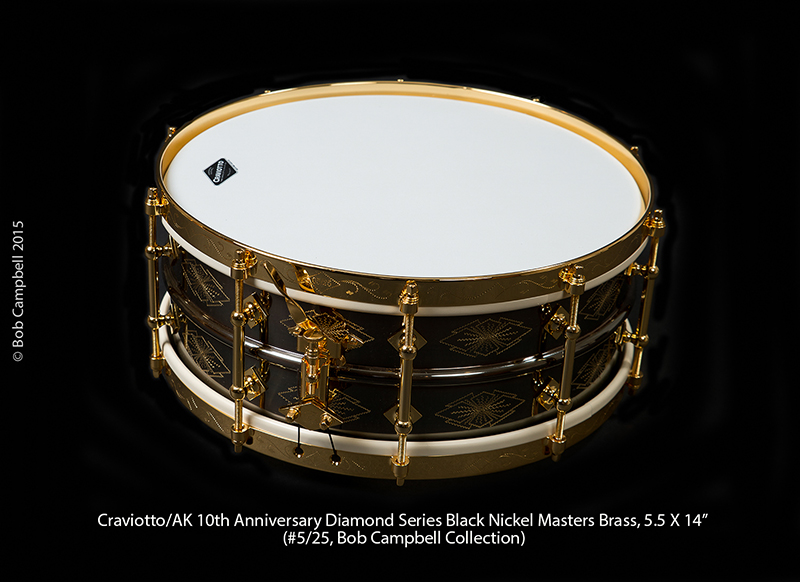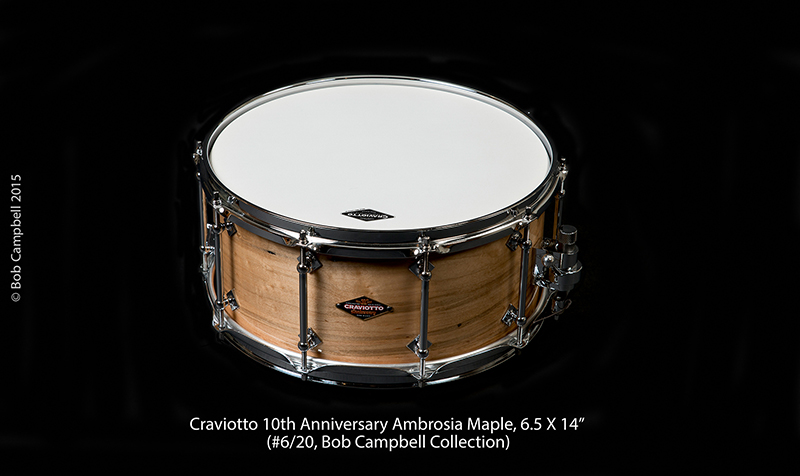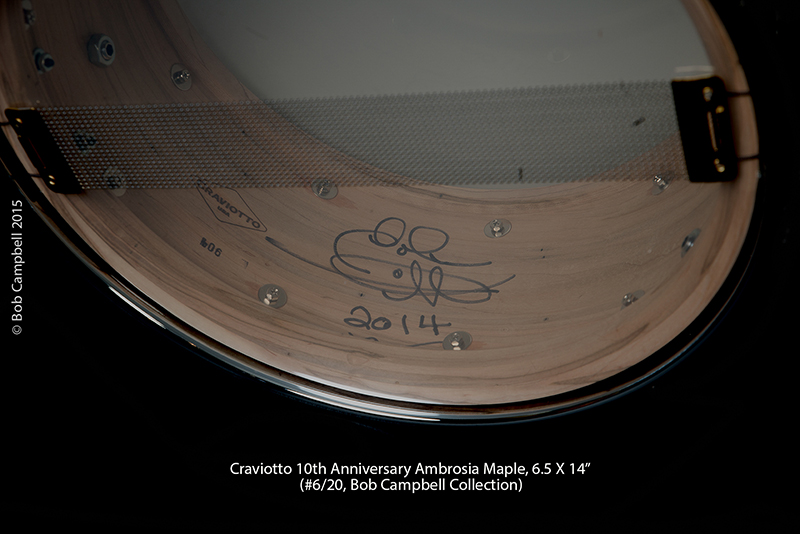Each month, I typically focus on one or two drums and the story behind their construction, and maybe even a cool story about their owner. This time, I’d like to change things up a little and share the story of a well-known craftsman, whose drums reflect the progressive evolution of his career – Johnny Craviotto. So in this case, many drums tell a story…
John “Johnny” Craviotto was born of Italian-American parents (mom from Florence, dad from Genoa) in San Francisco, CA. In the 1970’s, a young Johnny Craviotto started off his musical career as a professional drummer playing with noted artists such as Ry Cooder, Moby Grape, Neil Young, and Buffy St. Marie. At this time, he had also become an avid collector of vintage drums and developed a great admiration for the handiwork of the early drum builders.
JC: "I started collecting drums in the 70’s. I was a collector previously of other antiques and I then got interested in drums. I got my first Radio King in 1974. I kinda got infatuated a bit with these drums. I really started seriously collecting drums after that, around 1978. A year or two later, I was doing drum customizing and repairs. Before long, I was doing a lot of drum repair work. I started slowly with the local schools and then my name got out there in the Bay area. I began doing a lot of bearing edge work of course, and I was doing some re-wraps (you know, just general maintenance and repair work). Once in a while, these Radio Kings would come through the door. I was always really infatuated with the solid shell concept. I just always thought it was really, really cool. I started calling some of my colleagues that I had met from the collecting community, which at that time was pretty limited: Charlie Donnelly, Joe Montineri, Jim Pettit and Andy Florio. I was trying to pick their brains about how it all came about (solid shells), when it started and when it ended. There really wasn’t that much documentation that had been written on solid shell construction at that time. I kept going along and tried to learn as much as I could…"
Around 1979, Johnny did a stint in a boatyard working with a master boat builder. Little did he know that this experience would set the path for his future. While steam-bending boat ribs, Johnny began wondering if he might be able to translate this knowledge into making one-ply drum shells. Why? - because he loved the old Slingerland Radio Kings and wanted to build drums like them.
JC: “I had the opportunity around 1979-80 to work in a boatyard with a master boat builder. I was his apprentice and helper; the guy I was working with was really sharp. One day we were doing steam bending on some ribs on a boat, and I went home that night and started thinking about the (drum) shells. The next day, I brought a Radio King down that I had collected. I said to him, “you know, take a look at this thing; it’s a one-piece steam-bent shell. Do you think there’s a possibility that I’d be able to make one of these?” He said, “Absolutely. I don’t see a problem.” He gave me some pointers along the way and, with a lot of trial-and-error, I finally started rolling a few good shells (that was around 1984-85), but they were really rough. It took some machinery to really make it a go.”
So with the help of the master boat builder and much trial-and-error, Johnny began making his own one-ply drum shells. By 1984-85, Johnny had started to perfect his technique. Word of his drums spread until it caught the attention of Billy Gibson (Huey Lewis & The News). Billy asked Johnny to join forces with him to form a drum company, the Select (later changed to “Solid”) Drum Company.
JC: “So one day, Bill Gibson enters the picture. I knew one of his drum tech’s. His drum tech came to me and said, “Bill has heard about your repair work. Would you be interested in making him a couple of snare drums? I said, “I’d love to!” At that time, I didn’t have the machinery to make the solid shells, and I wasn’t able to buy the shells from Anderson or Keller direct, so I made him a couple of snare drums from the Corder Drum Company. I made a couple of snare drums for Bill and he was really impressed with them. I met him finally and things started to come together. He asked me if I would like to start a drum company and that he would like to be involved in it. I said, “yes, of course!” This gave me the capital to pursue the solid shell thing. I was able to buy some equipment and gather a small staff of people. We basically came up with the shell concept. At the beginning, the company was called “Select Snare Drums”. We had a little problem with the name, as it seems someone else had the rights, so we changed it to “Solid”. We went along for about two years and unfortunately had to fold the company. Gene D’Amico wound up buying all the rights to the Solid design. I took a couple of years off and I began tinkering around with drums. When I left the company, they tried to carry on for about six months after I left, but eventually folded. Consequently, they had a bunch of shells left over and the people at Solid sold them to Ross Garfield (current owner of Drum Doctors).”
While this endeavor with the Solid Drum Company only lasted a few years, Johnny’s passion for making drums was not to be easily dismissed. Johnny then focused his attention on perfecting his steam-bending technique. He was not content making only average shells; he wanted to be one of the best. In 1993, at the suggestion of Jim Keltner, he approached Don Lombardi of Drum Workshop, a.k.a. D.W., with some of his shells. This resulted in a long partnership with D.W. …
JC: “Ross (Garfield) started to put some drums together and consequently Jim Keltner and Jeff Porcaro got a hold of some of them. Some of my shells had gotten down to Los Angeles. Nobody had really said who had made these shells but then finally the truth came out that Johnny Craviotto had put the shells together (and Ross had purchased them). Phase Two of drum career I guess would be – I wanted to get something going again. I met Jim Keltner in 1972; I used to play with Ry Cooder before he did. We toured and whatnot for about 3 years. I heard that Jim had gotten few of the shells from Ross & I figured why not call Jim? Jim was working with Neil Young at the time who I had also worked with…They were up at Neil’s place, really close to my house. I drove up there and had a meeting with Jim. And I said, “You know, I’d like to get this drum company going again.” He said, “Wow, it’d be a good thing. Let me think about it”. He came back about a week later and basically said, “I’m not really up for this myself but I can turn you on to a guy named Don Lombardi at Drum Workshop and maybe you guys could put your heads together and come up with something.” I met Don, and we sat down to talk about co-branding ideas. I brought some of my shells for him to look at - I think that was in 1993. We signed a contract. I had my own facility, which allowed me to stay in the Monterey Bay area, and they had the rights to the shells; a co-branded DW/Craviotto drum. I was obligated to make so many shells per month. We put it together and showed at the NAMM show in 1994. It wound up being a good ten-year run with Don. We did a lot good stuff; my name got out there… They (DW) really took good care of me.
I went along with DW; we’re going along for about 3-4 years and just making maple shells. I was working close with DW’s marketing people, especially David Levine (brilliant DW marketer, was with DW for around 30 years). He said, “You’ve got a really unique thing. Can you come up with something different to keep the ball rolling?” He figured it would be unique if I could come up with some different woods. I said, “Well sure, I’ll give it a whirl.” So around the 4th or 5th year, I introduced oak, walnut and cherry shells with DW. We started rolling some shells to be sure I could make more than one quality shell and get somewhat of a production going. The cherry and walnut woods behaved pretty well. Walnut’s extremely stable. That’s what they use for gun/rifle stocks because they don’t move around and stay very tight. I did the oak; oak is really hard to work with; it’s not as easy as people think. It bends very easy but it wants to check (i.e., crack or split)…and that’s how I started to get into different woods, other than maple.”
Around 1999, Johnny came up with spectacular idea, which was to build drums from ancient, old growth wood recovered from sunken timber. He would go on to build a limited edition series of solid-ply drums made from 600 year old wood rescued from the bottom of Lake Superior. These drums were adorned with hoops engraved by master engraver, John Aldridge – the “Lake Superior Timeless Timber series.” A few years later, these were followed up with the Lake Superior Timeless Timber birch series of drums. These made a huge splash (no pun intended) in the drum community because of their amazing sensitivity, dynamic range, and attention to detail. They were aesthetic and sonic masterpieces.
JC: One day, I got two calls, one from a local guy and Tom Freer (now Timpanist with The Cleveland Orchestra and owner of Freer Percussion) letting me know that this wood had been on television, called the Lake Superior Timeless Timber (old growth wood that sank in Lake Superior some time in the 1800’s). They both said it would be cool if I could make some drums out of this stuff. They introduced me to this wood. I called them up (Enviro-Recovery); they were up in Ashland, WI. I said, “I’m a drum maker and I’d really be interested in getting some of the Timeless Timber. I’d love to make some drums out of it.” They wouldn’t give me time of day (laughs). They said, “Well, you know we’re not really interested…” After that, they started searching around a little bit saying “this crazy drum guy” called and “who is he?” I heard somebody said, “It was this guy Johnny Craviotto and he’s hooked up with DW. He’s a pretty serious drum maker.” So about a week later, they called me and said they were interested selling some of the wood. I said, “Hey, great!” and they said, “When can you come up here?” I said, “I’ll be on a plane tomorrow morning.” I got on a puddle jumper out of Chicago and then next thing you know I’m up in Ashland. I was thinking to myself, “Man, if I introduce this thing, I know everybody’s going to jump on it.” So I wondered if these people would be interested in doing an exclusive contract with me? I just threw it out there and they were open to it. They signed a contract. I was the only drum maker that had access to the wood. I got some birds-eye maple because I thought that would be a real home run. John Aldridge engraved the hoops for me. I made about a dozen drums. At that time, nobody knew about the drums, not even at DW. We made a short 3 ½ minute tape of the divers finding and cutting the wood, and me talking a little bit. I walked into Don Lombardi’s office about 4 days before the NAMM show and took the drums out of the box. He just absolutely flipped out; it was a home run. When he saw the video, he goes, “How did you put this all together?” I said, “I don’t know but it sure is cool; check these drums out!” So we go to the NAMM show with the drums, a video, and a small television set that had a VCR player that would repeat over and over. I had a beautiful Timeless Timber birds-eye board with me and set it up with the 12 Timeless Timber drums and the video. It was hit; just a huge hit. There was quite a buzz. We sold nearly all of the drums there at the first show.”
By 2002, Johnny found himself aspiring for more independence and found an investment partner, Elizabeth Cabraser, to establish his own company, The Craviotto Drum Company, with the slogan, “Handcrafted Solid Shells, Made in the U.S.A.” He did a couple of years of additional R&D to come up with his own diamond-base tube lug and the Craviotto diamond badge, his new signature. So started Phase III of Johnny’s career…
In 2004, The Craviotto Drum Company was officially off the ground, producing some of the best single-ply solid shell drums on the planet.
JC: “I had a passion; I didn’t want to quit. In 2002, I met up with a new partner to come up with the Craviotto Drum Company. I was still with DW and working on the side a little bit. I did a couple of years more of R&D to come up with my drum sets. So officially, the Craviotto Drum Company got off the ground in 2004.”
One of the hallmarks of the new Craviotto Drum Company is the eye-catching diamond-based tube lug…
JC: "This is an interesting story that actually goes back a ways. I want to tell this story because it’s important to help you understand how they led up to what I do. So let’s talk about the lug for a minute with the diamond base. I think that’s a pretty unique design; I really like that. I’ve always loved the tube lug but wanted to have something a little different. I was able to buy out a shop in 1980 in the Bay area. The owner had passed away; he had the shop since the early 1930’s. I met his brother who was in real estate and he didn’t want to deal with the drum stuff – there was a ton of it. When I bought the shop, I was able to take everything. I found a chime – the little ball that used to go on the early pedals that chime a cymbal that’s attached to the bass drum. They were always round. However, one day going through all the stuff that I collected from the shop, I found an unusually shaped chime. Somebody had gotten a piece of square bar stock and made a diamond in the ball. I kept that thing and I said to myself, I’m going to file this away – if I ever do my own drum, I’m going to use this design for the tube lug because I just love it – and I’ve never seen another chime like it.
When I started Craviotto Drum Company, I had some really great help. When I was with DW, I met some older gentlemen who were master machinists (they were making a few tube lugs for me early on). They said, “If you want some help ramping this thing up for DW, we have the machinery and can help you.” They were just a godsend. They helped me tool everything up for the drum sets, production of the snare drums, everything… So when I decided to do my own Craviotto drum and it was time to make the lug, I contacted one of these guys and said, “You remember the round foot that we always used on the tube lug? Well, I want to use the square bar stock.” These guys were just brilliant. Within 2 days, they had a set of ten of them sitting on my desk – I loved it. They’re hard to make; a bit time consuming and difficult, but I just love the (diamond lug) design."
Over the next nine years, Johnny released a number of wonderful limited edition, metal snare drums in collaboration with another master drum craftsman, Adrian Kirchler, a.k.a. “A.K.”
JC: “Once in a while, out of left field, somebody would go, “Hey Johnny, have you ever thought about making a metal drum?” I said, “You know, I’ve thought about it but if the right shell ever comes along, I’ll consider it.” I was always partial to the Ludwig heavy brass shell. I always loved that shell. I kept collecting so I had about 475-500 snare drums by this time (wow!). I still have close to 300. I’d look at other shells and think, “Not really.”
I have a good friend from Munich – Jürgen Wiehler – he was a guy collecting vintage drums & worked in a shop in Munich. I had met him at the Frankfurt Musikmesse show that I was attending every year with DW. We had a nice relationship because we were both really into the vintage drums. We were talking and I said, “You know something, if I could ever find anybody that could make that heavy brass shell, man, that’d really be super cool.” So I get this email from Jürgen (around 2004) and he said he found a guy that’s making “The Shell”. I’d heard this many times before so I said to myself, “Yeah, great, whatever…” Later that year, I went to the Amsterdam Vintage & Custom Drum Show put on by Tanco Baart and Winnie Mensink. I walked into the show and there was Jürgen! I said, “Hey, I got your email about the guy making the heavy brass shells; where’s he from? How do I got a hold of him?” So he says, “He’s sitting in the next room.” I said, “Wow – great!” I walked into the other room and that’s how I met Adrian Kirchler. I picked up his version of a Black Beauty, looked at everything pretty close – and wow – this guy nailed it. We just hit it off right from the beginning. I think I bought the very first drum (the A.K. Black Beauty) he ever sold so I was his first customer. I bought it for my business partner. It was beautiful. Over time, we became friends.
About 2 years go by, and around July, 2006, and I called him up and said, “You know Adrian, I’ve been thinking about a lot about some stuff; would you be willing to do a co-branded drum, an AK/Craviotto or Craviotto/AK or whatever?” He said, “I wouldn’t do it with anybody but you.” I was just elated. That guy’s a fantastic craftsman. I’m so glad I met him. He made the first drum; a brass shell with the diamond engraved in one just panel. I showed it to only a couple of people, like Jim Pettit (Memphis Drum Shop) and Steve Maxwell (Steve Maxwell Vintage & Custom Drums). Jim Pettit and I go back a long ways, over 35 years. I trust his judgment; he’s very sharp, a good guy and really into drums. I pulled it out of the bag and said to Jim, “What do you think?” He just lost it. He said, “Where’d you get this?” I said, “Check the shell out!” I had a completed drum with just a raw shell. I asked Steve, “What do you think if I made some? Do you think they would sell?” He said, “Are you kidding? This is cool.” I called Adrian up and said, “Listen - I tested the waters, it looks good, let’s do it. Let’s ramp it up and make fifty 5 ½” and fifty 6 ½“ nickel-plated brass diamond series snare drums, and we’ll introduce them at the 2007 NAMM show. I want you to come out and be in the booth when we introduce this thing.” It went so well. Within days, all the first 100 N.O.B. Diamond Series drums were sold.
So around 2009, we did another one – I think it was the Copper Diamond Series that came next (again, a limited run of fifty each of the 5 ½” and 6 ½”). People wanted a copper drum; a drum with body to it and a nice mid-range. So another couple of years went by, and I kept hearing ‘Got to do another drum with A.K.!’ I thought about it, went to sleep and woke up around 3 a.m. with an idea. A.K. made that 2-piece shell for Ludwig; why don’t we do a copper and brass drum? I called him the next day and he said, “I never thought of that. Yes, let’s do that one next.” That was the third offering in 2012, the Masters Metal brass/copper hybrid snare drum. (Note: Steve Maxwell said these 100 snare drums, again 50 each of 5 ½” and 6 ½” sold out in about 15 days). The fourth drum in the collaboration with A.K. was in 2013 - the Masters Brass snare, with a one-piece handmade raw brass shell. (Note: offered in 4 ½” [25 drums], 5 ½” [40 drums], 6 ½” [60 drums] and 8” [25 drums] depths. As before, these all sold out very quickly). In 2014, we decided to do a 10th Anniversary drum, so I thought, let’s do a Black Beauty.”
And with that, the 10th Anniversary Diamond Series Black Nickel Masters Brass was born. In the final design, these extremely limited edition (only 25 drums) were hand engraved and numbered 5.5 X 14” black nickel-plated drums with one-piece beaded shells (0.7mm thick), 24K gold-plated hardware, solid brass hoops, Craviotto signature diamond brass tube lugs and a Craviotto Vintage 3-point strainer. In homage to many vintage drums, the shell had soldered back bearing edges and crimped snare beds. Adrian Kirchler provided some insights to the design:
AK: “I made the first sketch for the NOB Diamond series shell pattern. I simply wanted to come up with something that would match the typical Craviotto diamond shapes (badge and tube lugs). The engraving on the 2014 10th Anniversary Black Diamond is just a more elaborated version of the NOB Diamond pattern. The hoop pattern HAD to be something diamond-shaped too, but I wanted some wave lines, as a pure diamond pattern would have been too “hard” in my eyes. The Craviotto/AK one-piece shells are all rolled and brazed. (the old Ludwig 2-piece shells were made of two rolled and brazed halves, joined at the center bead). I also make 2-piece brass shells, but I just didn’t want to come up with these again for a Craviotto/AK project, as I had done them some years before for Ludwig Drum Co.
The advantages of the folded-back & soldered bearing edges:
- You get great strength and you can work with very thin brass (0.7mm in my case) - Great sensitivity and shell sustain.”
In addition to the Black Diamond 10th Anniversary drum, Johnny also decided to produce a second Anniversary drum, this time with a wood shell, Ambrosia Maple. Ambosia Maple comes from maple trees that were infested with the Ambrosia beetle, leaving some interesting figuring on the shell. The beetle bores a network of tunnels into the wood. A fungus grows in these tunnels and produces the blue, gray and/or brown colors that one finds in these figures.
JC: "I’ve been very closely with one wood supplier, Mark Newton (one of my long-time wood suppliers, almost 25 tears now), we are able to go through the cutting mills back east and hand-select the material that works for our needs. I have four people in the shop that know how to grade the wood and know what I’m looking for. Every couple of years, depending on our supply, we send someone back to the mills. On one of these trips, our guy went through about a million board feet of maple. He called me and said, “I ran into this wood” calling “white wormy” and “and it looks like it has eels swimming it.” They found the wood in some bogs along the Erie Canal in New York. He emailed me a picture and we went searching for the name. It turned out to be Ambrosia Maple, and the figures were made by the Ambrosia beetle. They bore into the wood, making holes, and then a fungus discolored the wood, all those black streaks. I told him to get as much Ambrosia Maple as he could. I wanted to make some snare drums and even a kit. He brought it back and we started cutting it up. We hoped it would roll (steam-bend) and thankfully it did! We put some drums together. I tried to oil some shells at the beginning and it wasn’t quite as brilliant as I wanted. So to make the wood really pop, I decided to lacquer the shells. Everybody really loved them at NAMM. Those are also limited in number, with only twenty 5.5” and twenty 6.5” released worldwide. I was able to make a few of those drums, but we’re going to have to go the east coast to get more material. I was able to make around 8-10 kits too."
As an option for the Craviotto 10th Anniversary Ambrosia Maple, Steve Maxwell is also offering the Angel Drum hoops (Hungary) that are heavy chrome-plated steel with the tension rod holes expanding out about ½ inch from the head. It is somewhat like a cross between a single-flange and a die-cast hoop.
JC: “Angel hoops - They are nice hoops – I really like them. I think they do a fabulous job on the hoops. They’re made in Hungary. We did a couple of add-on wooden timbales for NAMM and used the Angel hoops. Chris McHugh was up the other day and he put some of them on his 14” snare drum – he loves them too. It gives him a whole other sound.”
So when asked what’s next from The Craviotto Drum Company…
JC: This year, we’re going to try to do some drums that target a mid-price point. I want to get more snare drums into the hands of players who don’t have a ton of money. It’s hard for students and younger people coming up that would love to have a Craviotto drum but just can’t afford it. We’re offering a really good, meat-and-potatoes, maple, solid shell snare drum with a new cast lug at a really good price point. I feel good about it. We’re calling it the “Johnny C.” series.
At NAMM this year, I did have one incredible kit; it was curly maple, Cadillac green kit with the curly maple showing in the middle. I’ve also done some stacked solid drums with some Ambrosia Maple in them too. There was some Ambrosia that was really light colored, with the black “eels”, but didn’t have as much figuring; a lot of custom shop stuff.”
The Johnny Craviotto philosophy:
JC: “I’m kind of adamant lately about drum-building in general; there’s a lot of stuff out there. My whole philosophy (and its not from an egotistic standpoint believe me) is that you have to make your own shells to qualify as a drum maker in my book. Guys who make their own shells can look at themselves in the mirror and say, “Yeah, I make drums. I’m a drum maker.” It’s got to start with the foundation, like a house; it’s got to be the shell. Everything else is just basically assembly. I still have a part in the building of my drums on a daily basis. I more or less select all the wood. For the one-ply shell, you have to hand-select the wood. Whether it’s a 10” tom or a 26” bass drum or a 14” snare, each piece of wood needs to be hand selected. I also do all the color matching for the wood joining, and scarfing (I have some new machines for the scarf joints).”
It has been my pleasure to share the story of a man who has spent decades trying to perfect his drum-building technique, collaborating with other master craftsman (like Adrian Kirchler) and keeping true to his core philosophy – “It’s got to start with the foundation, like a house; it’s got to be the shell.” As a great admirer of his drums and the man (a true gentleman and ambassador of the drum community), I look forward to seeing and playing Johnny’s next creations. In the process, I have also developed a tremendous respect for the original and vintage restoration work of Adrian Kirchler; I expect to see more cool stuff from him as well!
Acknowledgements: Many thanks to Johnny Craviotto and Adrian Kirchler for their valuable time in constructing this article, to Peter Bick for his expert photographic assistance, Steve Maxwell for keeping me up all things cool in the world of Craviotto, and to Lisa Campbell for proof-reading (and reminding me how woefully bad my grammar is… Oops! That’s grammatically incorrect, I think).
A Pictorial History of Craviotto Drums:






